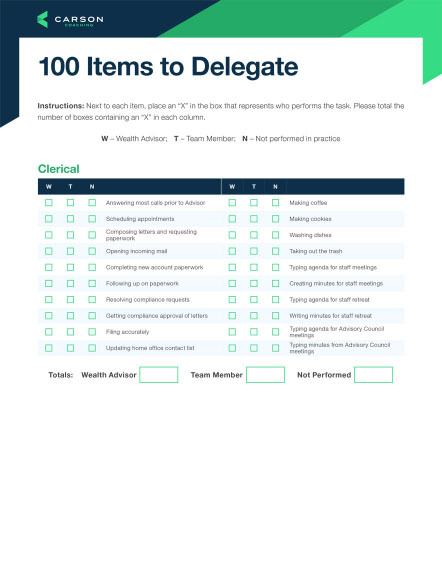I work with an advisor who enjoys great success in managing assets. He routinely outperforms the markets. “Chris” can tell you with great certitude the degree to which his portfolios align with the efficient frontier, beta, R-squared, Sharpe ratio, outperformance relative to benchmarks, allocation across asset classes, and myriad other details.
However, when the discussion turns to matters of new client acquisition and marshalling his resources to achieve the firm’s most important objectives, his comments begin to lose some of their clarity and punch. He gets fuzzy like fresh Georgia peaches in the warm spring sunshine.
Our conversations look something like this:
Coach: Hey, Chris, what are your plans for achieving the growth targets you’ve identified in your business plan?
Chris: Well, we’re going to…hold events in which we discuss our views on the market…and… engage centers of influence…and, you know…continue to ask clients for referrals.”
Coach: I see. What specific steps have you or your team members taken to plan your events, such as identify ideal participants, prepare materials, and select a date?
Chris: Yeah, things have been a little hectic with (fill in the blank). I’ve been meaning to get to that.
Coach: Uh-huh. You know most people are visual learners, and many accountants and attorneys don’t fully understand the range of services you provide, or the way you help clients avoid costly mistakes and achieve financial confidence. Given that, have you formalized the value story you want to present to COIs and developed a one-sheet or other prospect-facing materials that reinforces your key points?
Chris: That’s a great idea. It’s just so hard to get in front of these people, and for all the business I’ve sent their way, I hardly get anything back. There’s this one guy…
Coach: I understand. What language do you use to inspire clients to become your advocate? Do you empower them with introduction “scripts” they can use when they’re with friends, colleagues or neighbors? When do you typically ask for a referral – at the end of review meetings or at other times?
Chris: I just let them know that we’d be glad to help anyone they know who needs good advice.
Do you sound like “Chris”? If so, we’ve got your back.
Let’s make this simple. Wouldn’t you agree that at a high level, an effective investment management methodology would include due diligence, process and performance metrics? Why not apply those same three principles to managing your business?
Three concrete examples you can put to good use right now
1. Due Diligence: There are wide-ranging, road-tested business development strategies that align with all manner of personality types and work styles. Therefore, there are techniques that can work perfectly for who you are. What are the two to three initiatives you can commit to implementing? Don’t choose techniques simply because you believe others are using them successfully. Pick those that truly resonate. And of course, select strategies with a good track record of delivering successful outcomes. A good industry-specific coach can be enormously helpful here. See How A Coach Can Help You Ramp Up Growth.
2. Process: You’ve outlined your growth initiatives and other firm-level strategic priorities. (Those might be, for example, optimizing your staffing model, updating your branding and value story, delegating low priority work to others, modernizing the digital presence or establishing meaningful relationships with the adult children of top clients.) Now it’s time to determine what needs to be done when and by whom to bring these objectives to life, and develop a system to track and share progress, so that team members stay informed and accountable.
3. Performance Metrics: You wouldn’t consider managing assets without meaningful success measurements, a reliable method of tracking results and a compelling way to report those results to interested stakeholders, right? So, if it works for portfolio management, it also works for managing your business. Identify the data points you most care about that gauge the firm’s financial health, asset flows, and the degree to which the firm is expanding its reach in the community, in the minds of local professionals, and in the hearts of your best clients. You’ll need to help the team develop procedures to gather the data systematically, and you’ll want a tool that enables you to monitor this “report card.”
Making It Work in the Real World
Advisors I work with generally excel at attracting and retaining clients, as well as at the technical aspects of investment management and financial planning. But with a handful of exceptions, they are indisposed to moving ideas into action. They would prefer to pour salt and lemon juice on an open wound rather than manage an implementation plan.
So, how do you solve for that? Here’s how: Advisors need to outsource the “get it done” part. Unless you’re one of those rare advisors who can bring home the bacon and fry it up in the pan, you need an implementation partner.
This is someone on your team (or a new hire) who is as gifted at planning ahead, prioritization, and seeing things through to completion as you are at landing the $2M prospect you just met. I genuinely believe this is the single most important thing you can do to convert your aspirations to real-world triumphs, to turn your business plan from an assemblage of pretty words into an actual roadmap your team will use to get to the destination you’ve been dreaming about.
I invite you to apply the same intellectual rigor, intention and follow-through to realizing your business ambitions as you do to managing portfolios.


